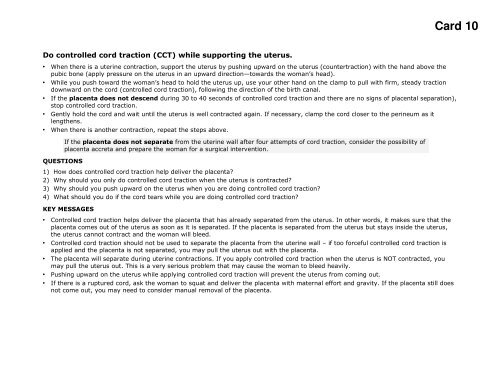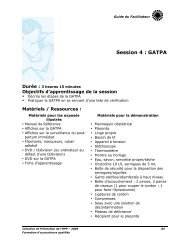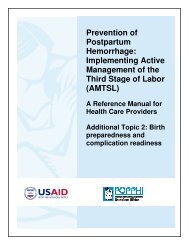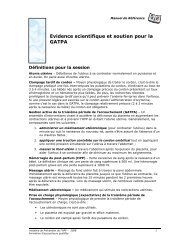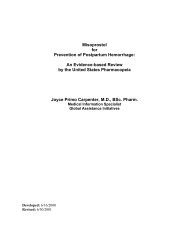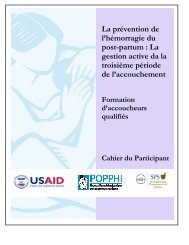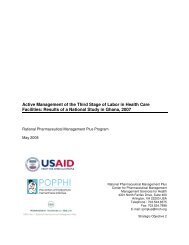English version PDF - POPPHI
English version PDF - POPPHI
English version PDF - POPPHI
Create successful ePaper yourself
Turn your PDF publications into a flip-book with our unique Google optimized e-Paper software.
Card 10Do controlled cord traction (CCT) while supporting the uterus.• When there is a uterine contraction, support the uterus by pushing upward on the uterus (countertraction) with the hand above thepubic bone (apply pressure on the uterus in an upward direction—towards the woman’s head).• While you push toward the woman’s head to hold the uterus up, use your other hand on the clamp to pull with firm, steady tractiondownward on the cord (controlled cord traction), following the direction of the birth canal.• If the placenta does not descend during 30 to 40 seconds of controlled cord traction and there are no signs of placental separation),stop controlled cord traction.• Gently hold the cord and wait until the uterus is well contracted again. If necessary, clamp the cord closer to the perineum as itlengthens.• When there is another contraction, repeat the steps above.QUESTIONSIf the placenta does not separate from the uterine wall after four attempts of cord traction, consider the possibility ofplacenta accreta and prepare the woman for a surgical intervention.1) How does controlled cord traction help deliver the placenta?2) Why should you only do controlled cord traction when the uterus is contracted?3) Why should you push upward on the uterus when you are doing controlled cord traction?4) What should you do if the cord tears while you are doing controlled cord traction?KEY MESSAGES• Controlled cord traction helps deliver the placenta that has already separated from the uterus. In other words, it makes sure that theplacenta comes out of the uterus as soon as it is separated. If the placenta is separated from the uterus but stays inside the uterus,the uterus cannot contract and the woman will bleed.• Controlled cord traction should not be used to separate the placenta from the uterine wall – if too forceful controlled cord traction isapplied and the placenta is not separated, you may pull the uterus out with the placenta.• The placenta will separate during uterine contractions. If you apply controlled cord traction when the uterus is NOT contracted, youmay pull the uterus out. This is a very serious problem that may cause the woman to bleed heavily.• Pushing upward on the uterus while applying controlled cord traction will prevent the uterus from coming out.• If there is a ruptured cord, ask the woman to squat and deliver the placenta with maternal effort and gravity. If the placenta still doesnot come out, you may need to consider manual removal of the placenta.


